Use the weight formula W = mg Solve for mass Substitute one newton for weight and one standard earth gravity for gravity m = W = 1 N g 98 m/s 2 m = 0102 kg = 102 g The 967 gram tangerine comes closest to this value Not all tangerines weigh 987 grams, however, so this is only a rule of thumb There are certainly apples, bananasW = Mg Formula (convert (lbs) Pounds To Kilograms) (3) A Bicycle And Its Rider Together Have A Mass Of 80 Kg If The Bicycle's Speed Is 6 M/s, The Force Needed To Bring It To A Stop In 4 S Is F = M× ( A) Formula This problem has been solved!The equivalent mass of one Newton in earth gravity is 1 / kg on Earth This equivalent weight is derived based on the Second law of Issac Newton Here is the online Newtons to kg calculator to convert N to kg within the fractions of seconds as soon as you input the values This N to kg calculator is designed considering Newton
2
W/t formula
W/t formula-W = mg W weight (N) m mass (kg) g acceleration due to gravity (m/s2) Mass Note that mass is involved in the force of gravity!Question 2 Write Newton's Law of Universal Gravitation Why is this different than our weight formula W = mg?
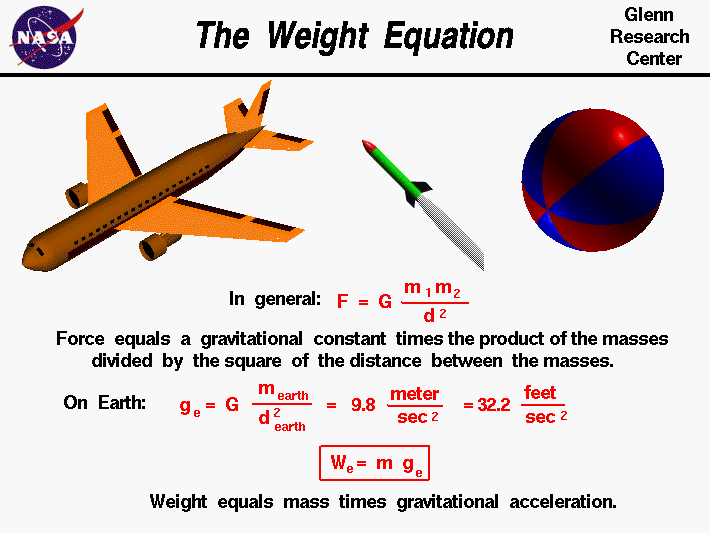



Weight Equation
Using the formula, the force can be expressed by the product of mass and acceleration of the body F = ma Weight Formula The formula measures the force with which an object falls due to gravity W=mg Pressure Formula Pressure refers to the amount of force applied per unit area of the object P=FA Ohm's Law Formula The most common definition of weight found in introductory physics textbooks defines weight as the force exerted on a body by gravity This is often expressed in the formula W = mg, where W is the weight, m the mass of the object, and g gravitational acceleration What weight should I be?And theeeen,we substitute that mass in the next formula,like this,ok?
The weight of an object is the force of gravity on the object and may be defined as the mass times the acceleration of gravity, w = mg Since the weight is a force, its SI unit is the newton Density is mass/volume IndexHere, w = 250 Nw and g = 16 m/s 2 W = mg m = w/g m = 250Nw/ 16m/s 2 m = kg Hence, the mass of the individual is kgWwwformuladcomWelcome to Formula DRIFT, the Official home
Weight formula w=mg potential energy formula Ep=mhg kinetic energy formula Ek= 1/2 m v^2 Efficiency formula e=work out/ work in (100) work output always less than work input fulcrum point on a lever that rotates input force force applied to leverW = mg W = 70 × 98 W = 637 Nw Hence, the weight of the person is 637 Nw Q2 An individual weighs 250 Nw on the moon Calculate the mass of the individual considering the gravity on the mass as 16 m/s 2? PoundsMass (lb·m) PoundsForce (lb·f) = lbm·ft/s 2 Formula W = mg Mass is a constant property of an object Weight varies with the gravitational field It's not as complicated as you think Every time you see the unit of pounds, it may or may not have the acceleration of gravity included in it W = mg
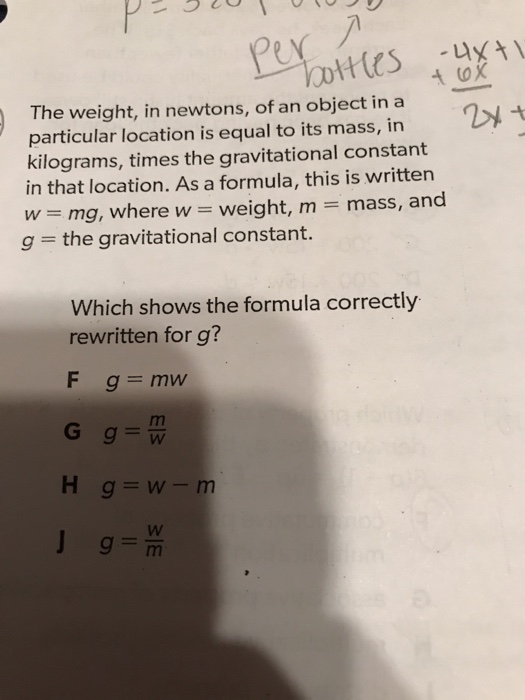



Solved The Weight In Newtons Of An Object In A Particul Chegg Com



2
NSC24™ IMMUNITION Allergy Formula w/MG Beta Glucan nutritionally potentiates certain immune cells to reduce inappropriate immune cell responses to allergens from pathogens This in turn, yields a nutritionally induced reduction of inappropriate allergic responses associated with an malfunctioning immune responseUsing the formula to find weight, W = mg W = 50 × 98 W = 490 N Answer The weight of the body is 490 N Example 2 If the weight of the body on the moon is 500N, find its mass The value of g in the moon is 162 m/s 2The formula for weight is given by w = mg As weight is a force its SI unit is also the same as that of force, SI unit of weight is Newton (N) Looking at the expression of weight we see that it depends on mass and the acceleration due to gravity, the mass may not change but the acceleration due to gravity does change from place to place




Immunition Nsc Respiratory Formula W Mg Beta Glucan Nutritional Scientific Corporation




How To Calculate Weight The Weight Equation Fw Mg Youtube
analyze the formula W= mg to explain how an objects weight can change even when its mass remains constantSo, w=mg w=600kg*10ms2 w=6000kgms2Find patient medical information for Renal Multivitamin Formula oral on WebMD including its uses, side effects and safety, interactions, pictures, warnings and user ratings




We Know F Mg Why Quora




Objects With Mass Also Have Weight Although They Can Chegg Com
Formula for weight is, W = mg W = 60×1625 W = 975 N Problem 2 Compute the weight of a body on earth whose mass is 25 kg?M = mass of object;G = local gravity (eg standard earth gravity or g 0 = ms2) Mass of Object Enter the mass of the object that you wish to determine the gravitational weight Acceleration Due To Gravity




The Formula To Calculate The Weight Of An Object Is W Chegg Com



Chapter 4
Peso El peso de un objeto se define como la fuerza de la gravedad sobre el objeto y se puede calcular como el producto de la masa por la aceleración de la gravedad, w = mg Puesto que el peso es una fuerza, su unidad SI es el Newton Para un objeto en caida libre, la gravedad es la única fuerza que actúa sobre él, por lo tanto la expresión para el peso derivada de la segunda ley deWeight/Force is the gravity on an object, the formula is W = m × g Where W Weight/Force, in N m Mass of the object, in kg g Gravity, in m/s^2Formula The calculation formula used for this tool is F g = m g Symbols F g = weight or force due to gravity of object;




The Formula For Tension In A Rope Attached To A Weight At An Angle Dewwool




Weight
Why is this different than our weight formula W = mg? In this formula, W = mg, one can find the mass by rearranging this formul = m1 Answer1 Your method looks correct W = m g, therefore m = W / g Therefore m = 58 / 4 = 145 k g Therefore your book has got the answer wrong unfortunately The book used g = 10 m / s / s, which is approximately the acceleration due to gravity on Earth




Calculating Weight Mass Using W Mg Teaching Resources




Edexcel International Gcse Science Physics Sample Chapter By Collins Issuu
Weight is the force exerted on the mass of an object due to gravity and a specific case of Newton's Second Law of Motion Replace force with weight and acceleration with acceleration due to gravity on Earth (g) and the result is the formula for weight W = mg or, substituting for g, weight equals mass multiplied by 98 m/s 2The weight W=mg acting downwards through G and the buoyancy force, of equal magnitude, acting upwards are not in the same line but form a couple W×GZ, where GZ is the perpendicular on to B 1 M drawn from G If M is above G this couple will restore the body to its original position and in this condition the body is said to be in stableBecause m*g is an approximation near the earth's surface, albeit a good one Look at the 1/r^2 term near the earth Set re=radius of the earth and h as the height above the earth 1/r^2=1/(reh)^2 =1/re^2/(1h/re)^2 now expand (1h/re)^2 =12*h/re




How To Calculate Weight From Mass 10 Steps With Pictures
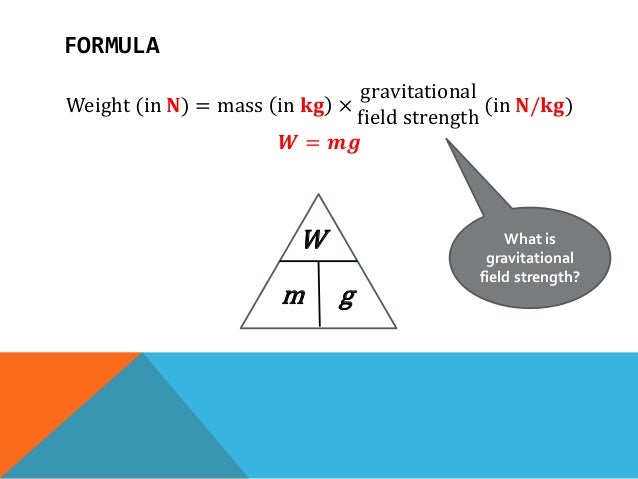



Na Mass Weight Density E Learning
Thanks for "LIKING" Remember that weight is measured using a scale in newtons and mass is measured using a balance in kilograms The relationship betweenLike energy, it is a scalar quantity, with SI units of joules0 out of 5 $ 4995 $ 4246 Club 24 price $
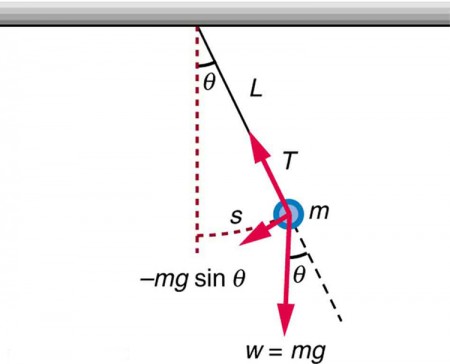



The Simple Pendulum Physics




Show How To Find W Mg Youtube
How many mL should be administered per day?Related products15% Add to cart Add to wishlist Quick View Add to wishlist Cardio / Circulatory, Energy, Immune System Immunition NSC CoQ10 and MG Beta Glucan! The weight of a body is given by the formula W = mg, where W is the weight in grams, m is the mass of the body in grams, and g is the acceleration due to gravity For Earth, g = 98 meters/sec2 Find the weights of these body masses m = {24, 37, 95, 136, 534}
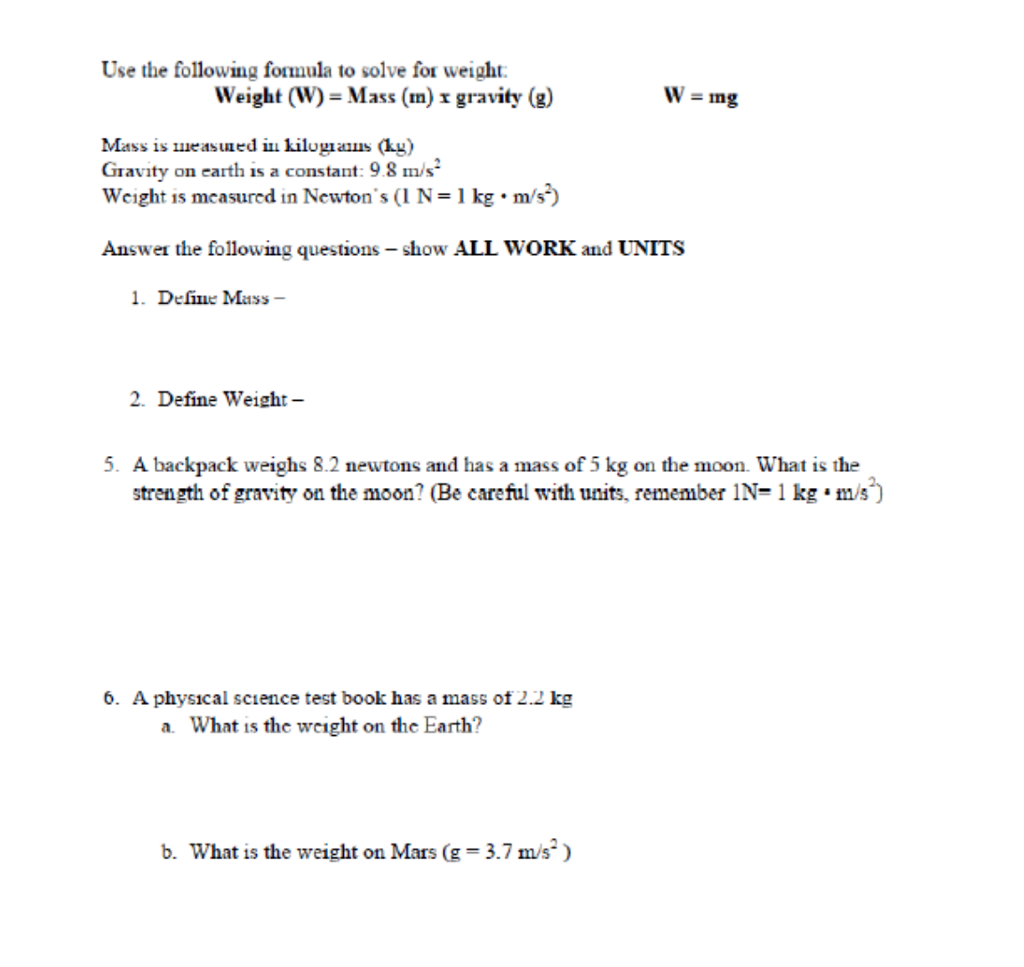



Use The Following Formula To Solve For Weight Chegg Com




Justphysics
Immunition NSC EyeCare Formula w/MG Beta Glucan!Subscribe to Formula DRIFT http//owly/mhLYiThe 21 Season is on and tickets are on sale now!This problem has been solved!




How To Calculate Weight From Mass 10 Steps With Pictures



2
SAT Subject Physics Formula Reference Kinematics (continued) v2 f = v 2 i 2a∆x v f =finalvelocity v i =initialvelocity a =acceleration ∆x =displacement Use this formula when you don't have∆t Dynamics F = ma F =force m =mass a =acceleration Newton's Second Law Here, F is the net force on the mass m W = mg W =weight m =mass g =accelerationdue to gravityFor this oral dosage problem, you have to find out how many mL of tetracycline the patient will get when the doctor has ordered 150 mg and the syrup has 50 mg/ml This problem is set up and calculated as shown below 150 mg x mL = 50 mg 1 mL 50 x = 150 X = 150/50 = 3 mLThis is a separate property from that of inertia, so we give this property the name gravitational mass • is a measure of how much matter there is in




Warm Up Finish The Formula For Force Weight F Ma W Mg M A G Ppt Video Online Download
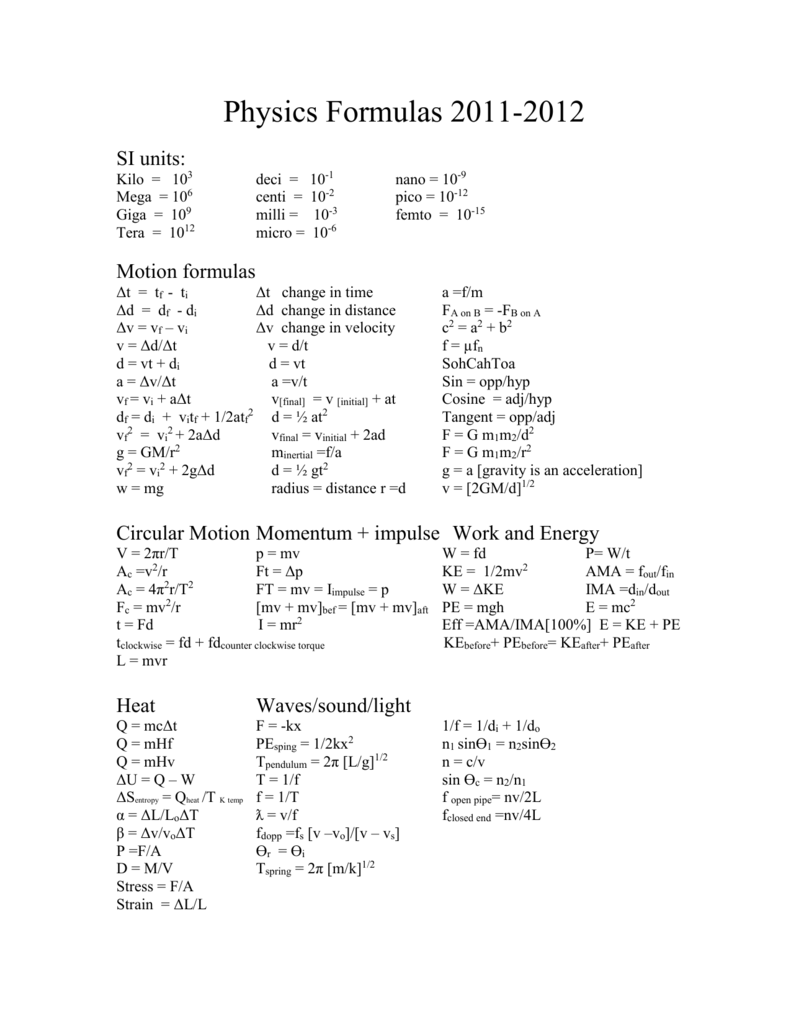



Physics Formulas 11
Newton's 2nd law of motion deals with situations when a net force is acting on a body It states that "When a net force acts on a body, it produces an acceleration in the body in the direction of the net force The magnitude of this acceleration is directly proportional to the net force acting on the body and inversely proportional to its mass"Answer It is known that, m = 25 kg and g = 98 m/s 2 Formula for weight is, W = mg W = 25×98 W = 245 N This is often expressed in the formula W = mg, where W is the weight, m the mass of the object, and g gravitational acceleration Who gave the formula of work?




Formula For Preparation Of The Matrix And Immediate Release Layers Of Download Scientific Diagram
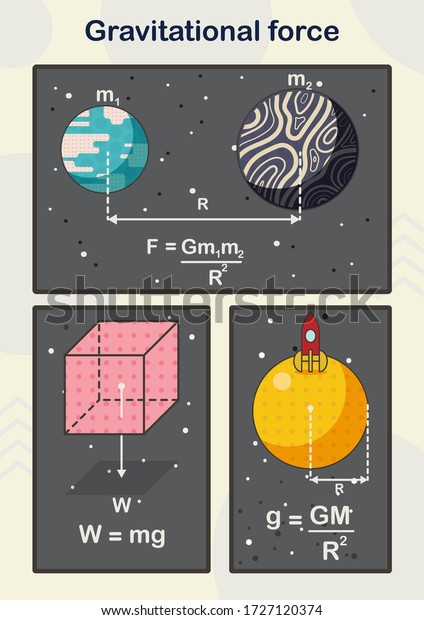



Gravitational Force Part Fundamental Force Picture Stock Vector Royalty Free
W = mg From Newton's third law of motion, the weight is balanced by the normal force W = F N Or, F N = mg Therefore, the formula for the magnitude of static friction is given by F S = μ S mg Work done W by force is given by the product of force and displacement d W = F x d Since the static friction force does not displace the objectWeight = Mass × Gravity You may also wish to learn the formula as W = mg Question 1 The strength of gravity at the Earth's surface is 10 newtons per kilogram Calculate the weight of a car with a mass of 1500 kg Question 2 The strength of gravity onW = mg m = 100 g = 01 kg g = gravitational field strength g = 10 N/kg W = 01 kg x 10 N/kg W = 1 N So, a force of 1 N is the force need to lift an average sized apple off the ground The Wmg




The Formula For Tension In A Rope Attached To A Weight At An Angle Dewwool



2
Then, you have to substitute the value you find for the mass in the previous formula to this formula For example,if the density is 60, and volume is 10 then the mass would be as follows, D=m/v 60=m/10 m=60*10 m=600kg// Get it? Physicists calculate the weight of an object by multiplying its mass by the gravitational force acting on it, using the formula W=mg, where W is the weight, M is the mass, and G is the gravitational force acting on it Gravity on Earth is force exerted by the planet onto objects upon its surfaceThe simple formula W = Mg where W is the weight in Newtons, M is the mass in kilograms, and g is the acceleration of gravity at the surface in meters/sec 2 For example, on Earth, g = 98 m/sec, and for a person with a mass of 64 kg, the weight will be W = 64 x 98 = 627 Newtons Since 98 Newtons equals 22 pounds, this




Weight And Mass W Mg Youtube
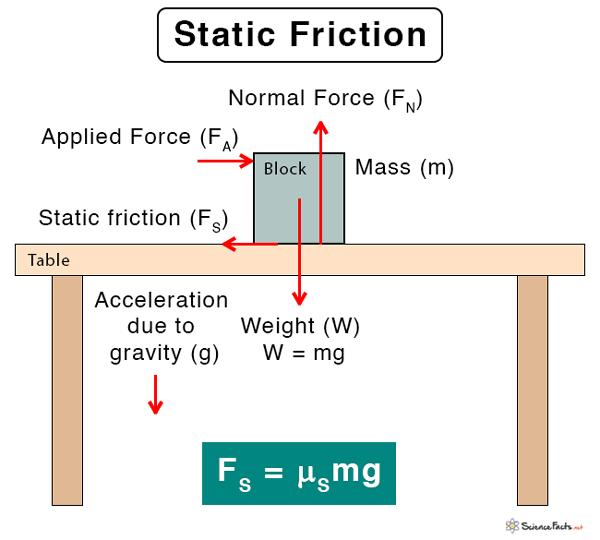



Static Friction Definition Formula And Examples
Start studying Forces and Motion Learn vocabulary, terms, and more with flashcards, games, and other study toolsFree math problem solver answers your algebra, geometry, trigonometry, calculus, and statistics homework questions with stepbystep explanations, just like a math tutorWeight and height guide chart




How To Calculate Weight From Mass 10 Steps With Pictures



Chapter 11
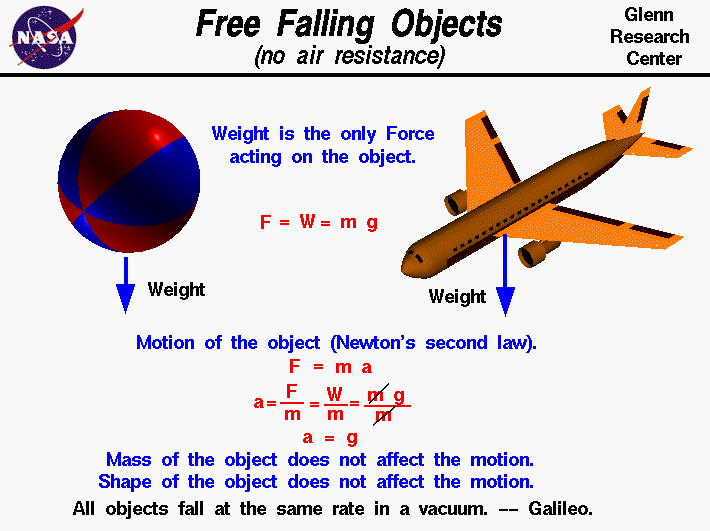



Free Falling Object




Weight Formula Definition Weight Equation Examples




Gravity And Weight Omar Has The Following 1




Buoyant Force Problems And Solutions Solved Problems In Basic Physics




Mass Weight Density



All Equation Manipulation Tpsscience




Nsc Immunition Allergy Formula W Mg Beta Glucan Nsc Catalog



Chapter 4
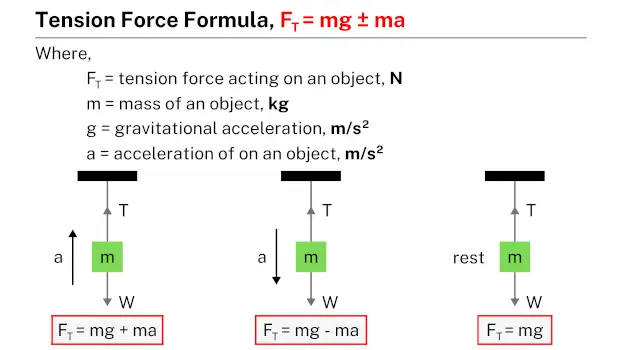



Tension Force Formula Problems With Solutions Learnool




Derive That W Mg Brainly In



What Is The Definition Of Weight Density Quora



1




Weight Formula What Is Formula To Find Weight Examples
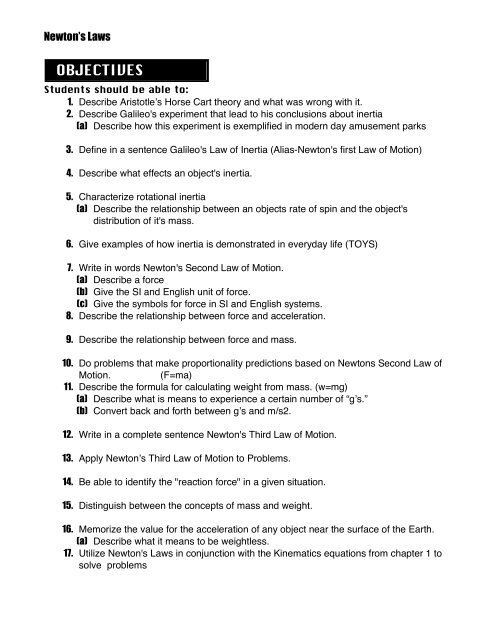



Newton S Laws Worksheets
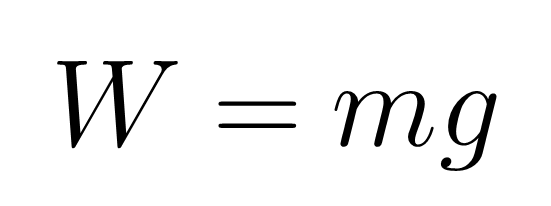



Physics Formulae Today S Formula Of The Day The Definition Of Weight The Weight Of An Object In A Uniform Gravitational Field Is Equal To The Mass Of The Object Multipli



Earth Orbits




Aqa Synergy Physics Equations For Display Teaching Resources




Lab 1a V 2 Weight Is Dependent On The Mass Of The Chegg Com




Weight Mass And Density Unit Conversions Definitions Examples




Sir Isaac Newton Laws Of Motion Physical Science




Physics Formulas Ap Physics Physics




W Mg Example 1 Youtube




Is It True That Using The Formula W Mg For Weight Only Accurate While Near The Surface Of A Planet Quora




How To Calculate Weight From Mass 10 Steps With Pictures




Physics Lesson 2 9problems Involving The Application Of The Formula F Ma And W Mg In Pulley System And Lift Weight Lift Force



1
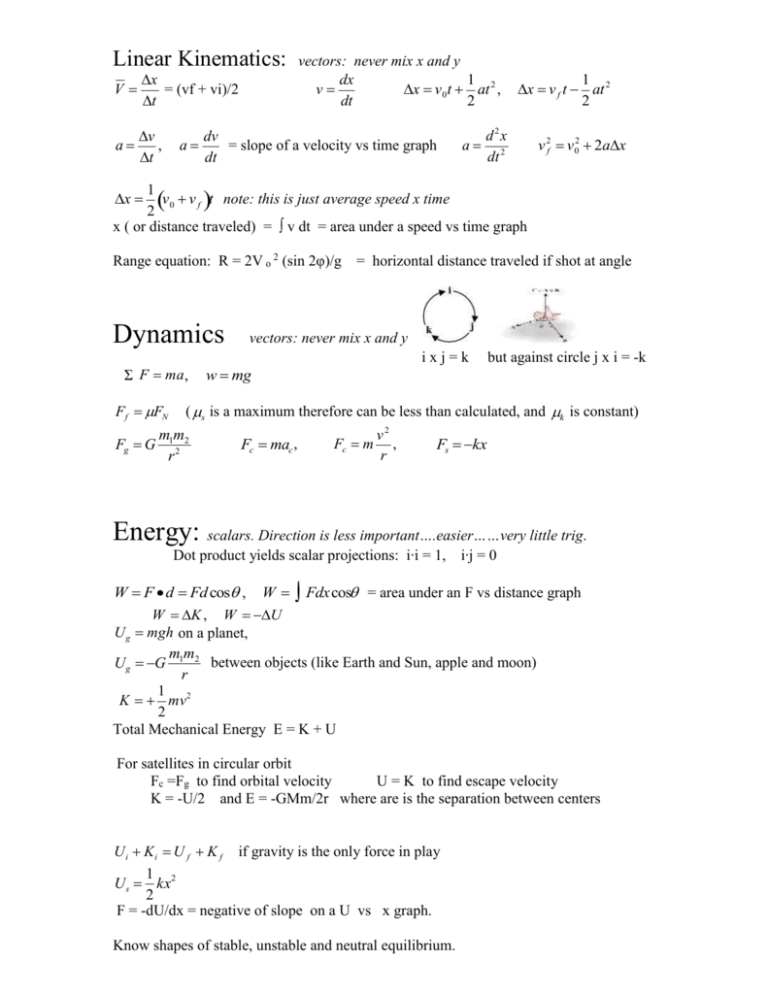



Ap Physics C Mechanics Formula Sheet




Analyze The Formula W Mg To Explain How An Objects Weight Can Change Even When Its Mass Remains Brainly Com




Weight Is The Result Of Gravity On An Objects Mass
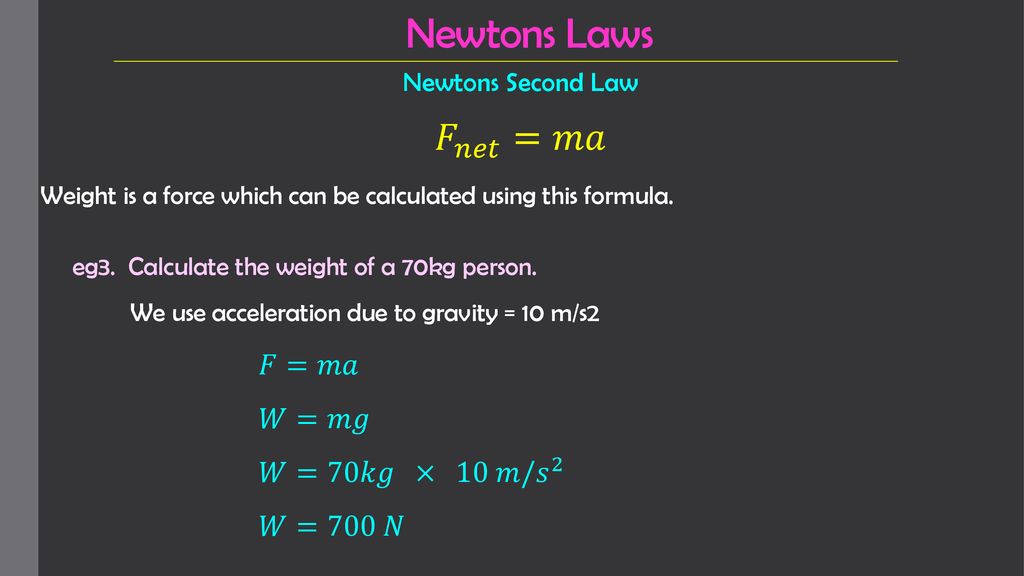



Motion Physics Unit Ppt Download



2




Warm Up Finish The Formula For Force Weight F Ma W Mg M A G Ppt Video Online Download



Chapter 4



1




Nsc Immunition Eye Care Formula W Mg Beta Glucan 30 Capsules My Natural Life Ebay
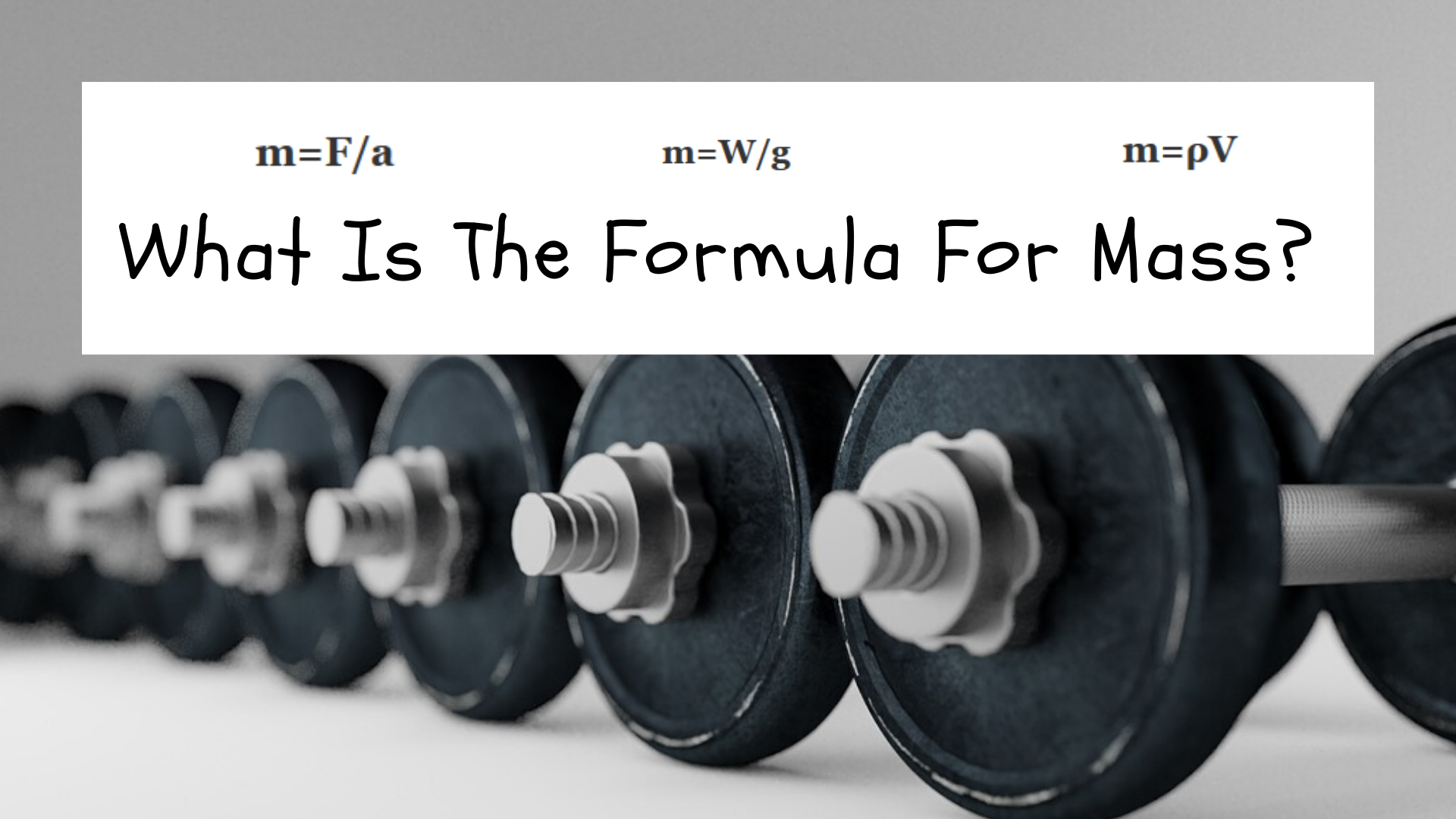



What Is The Formula For Mass Science Trends




F Ma And W Mg Youtube




Topgcsegrades Physics 2a Weight Mass Gravity



Mass Weight Density



Mass Weight Density




Calculating Weight Mass Using W Mg Teaching Resources




Please Give Me Numericals Based On The Formula W Mg Weight On Moon 16 Of Science Gravitation Meritnation Com




Flash Formula Forces




Difference Between Mass Weight By Isaiah Velasquez



Mass Weight Density



2




The Mass Of An Object And It S Weight Are Different Things Here We Ll Show You How Mass Weight And Gravity Are All Related Ppt Download




Weight Equation




Normal Tension And Other Examples Of Forces Physics




How To Calculate Weight From Mass 10 Steps With Pictures
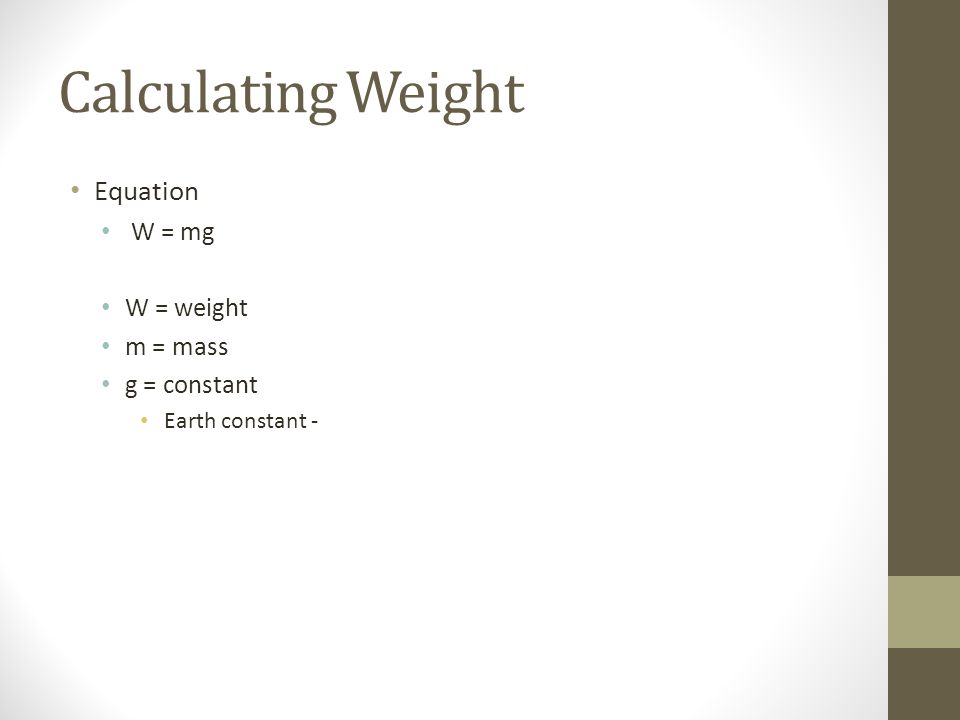



Mass Vs Weight Ppt Video Online Download




Section 2 Part 1 Gravity Learning Goals Describe
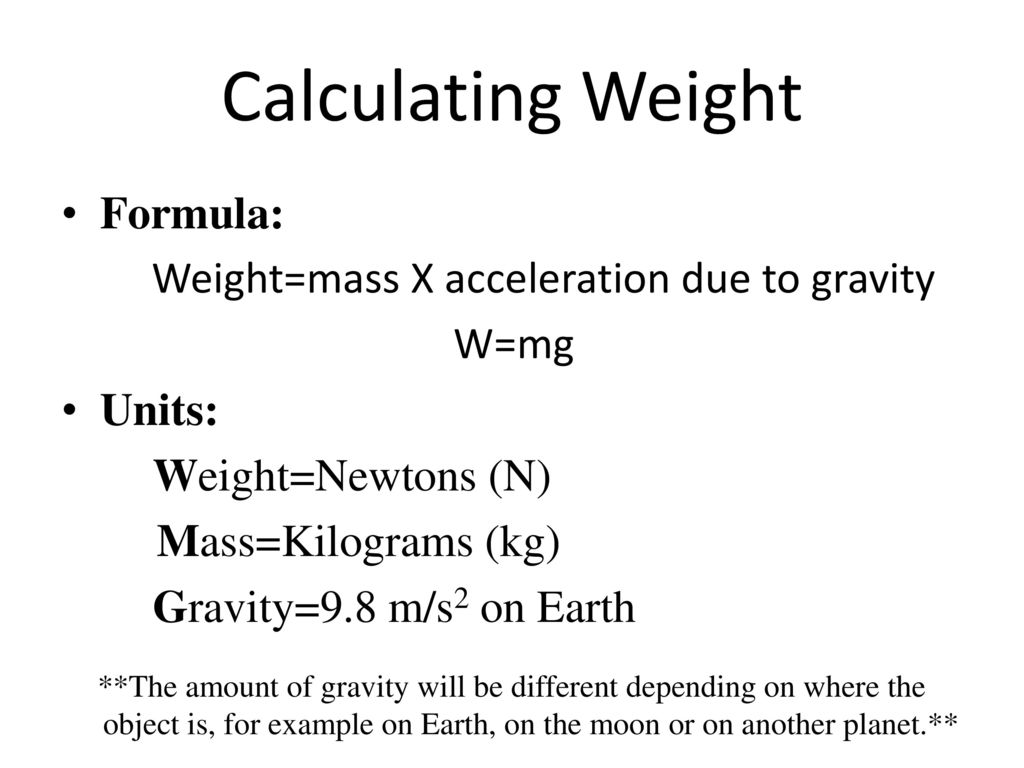



Work Mechanical Advantage Weight Review Ppt Download




Analyze The Formula W Mg To Explain How An Objects Weight Can Ch
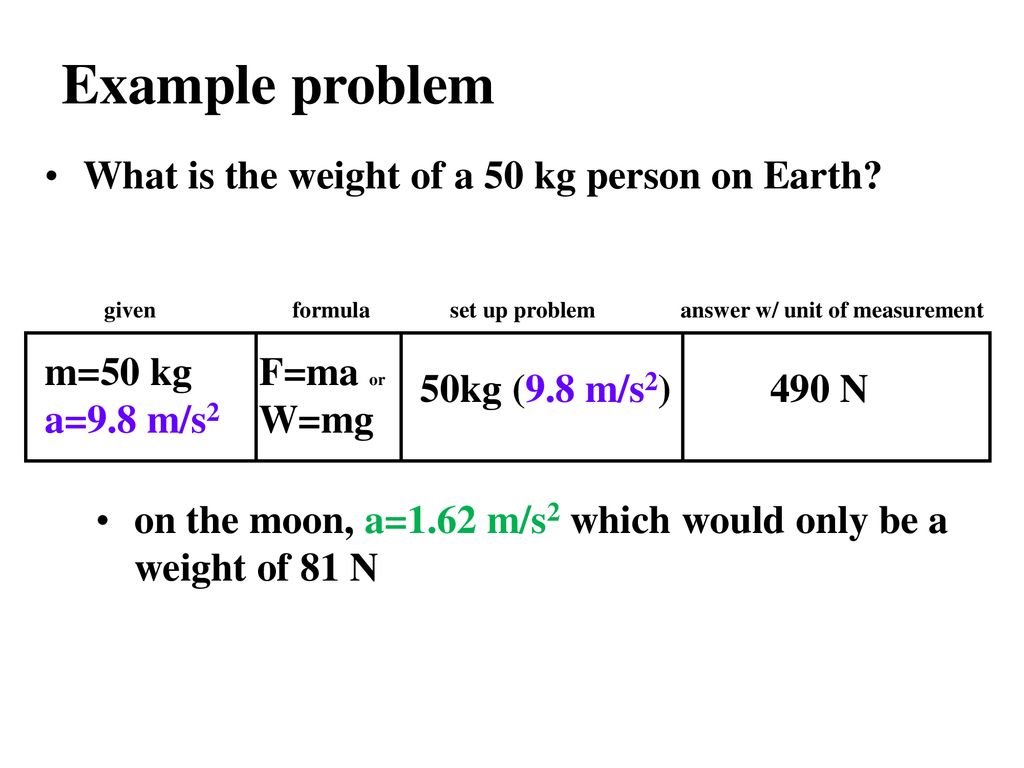



Gravity And Weight Ppt Download




12 2 Newtons First And Second Laws Of




The Difference Between Weight And Mass And Why It Matters Wired
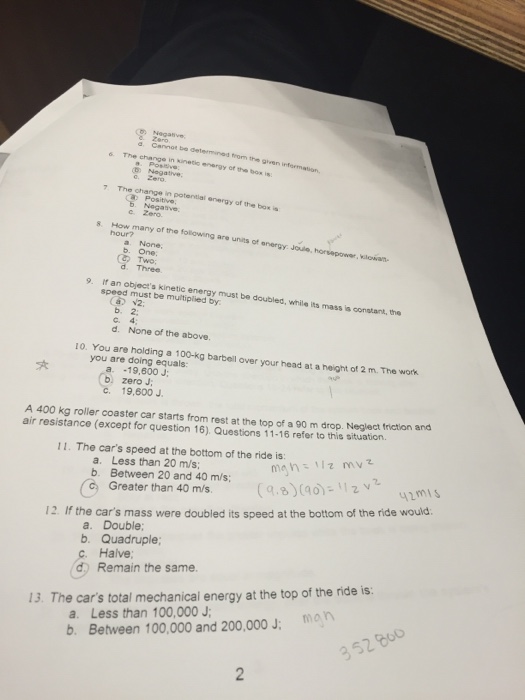



Formulas 80 M S2 W Mg Acceleration Of Gravity Chegg Com




Physics Formula Equations 9 1 Aqa Flash Cards By Qaasim Khan Issuu




How To Calculate Weight From Mass 10 Steps With Pictures
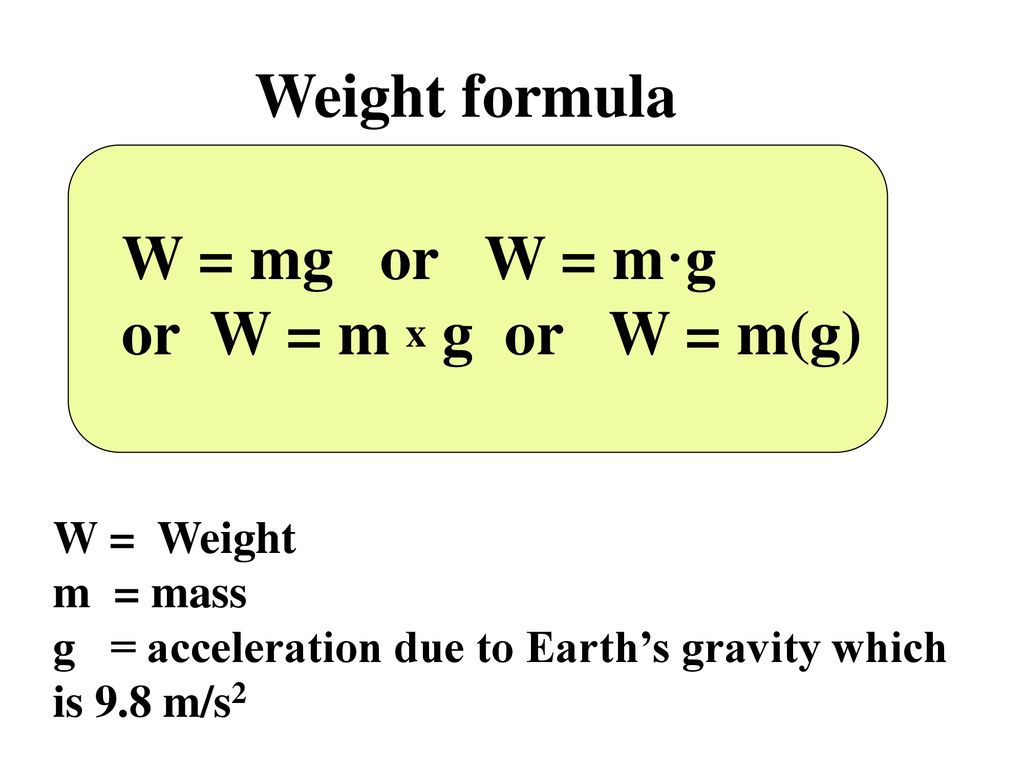



Gravity And Weight Ppt Download




Physics Notes Mass Gravity And Weight Calculations



All Equation Manipulation Tpsscience



New Page 1
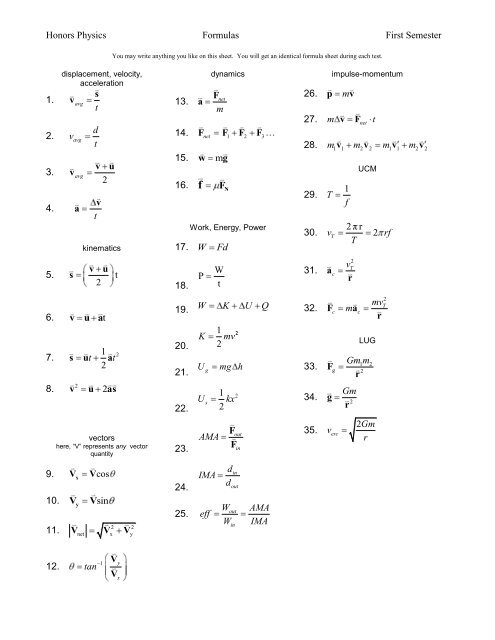



Formulas Suvat Pdf
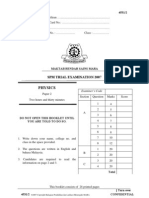



Physics Lesson 2 9problems Involving The Application Of The Formula F Ma And W Mg In Pulley System And Lift Weight Lift Force




P 2 1 3 Terminal Velocity P 2




Physics 1021 Lecture Notes Fall 16 Lecture 5 Microsoft Powerpoint Projectile Motion
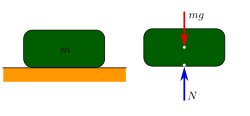



Weight Wikipedia



1




W Mg Youtube




Show How To Find W Mg Youtube




Basic Physics Formula Definition Equations Examples




The Weight Of A Body Is Given By The Formula W Mg Where W Is The Weight In Grams M Is The Mass Of Brainly Com



0 件のコメント:
コメントを投稿